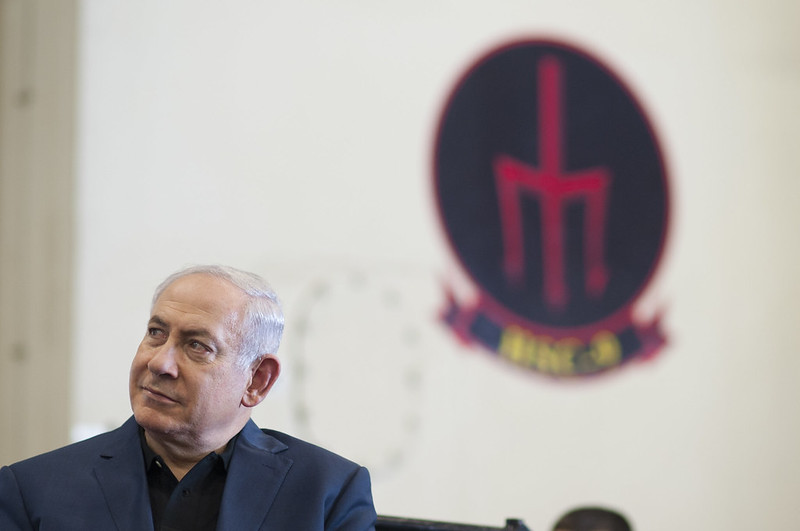
170703-N-AF077-1302 HAIFA, Israel (July 3, 2017) Israeli Prime Minister Benjamin Netanyahu listens to remarks made during a visit to the aircraft Carrier USS George H.W. Bush (CVN 77). The ship is in Haifa, Israel for a scheduled port visit to enhance U.S.-Israel relations. (U.S. Navy photo by Mass Communication Specialist 1st Class Sean Hurt/Released)
In Israel and abroad, analysts are wondering who is to blame for the terrible attack on the country by Hamas. At Foreign Policy magazine, Elena Grossfeld suggests that Israeli infighting between its conservative government and its intelligence services played a part in the failure. She writes:
For years, Israel has been unable to achieve a consensus on a two-state solution, placing its faith instead in military approaches and technology. It appeared that the status quo would remain forever, with a constant but sufficiently low number of Israeli victims interspersed with occasional flares of violence. Israel’s pullout from Gaza in 2005, designed to provide Israeli citizens with maximum security, and the construction and continued enhancement of the barriers around Gaza were both attempts to sweep the issue under the rug and contain the violence within.
The new concept allowed for the imagination of a perpetual low-violence solution, justified by the lack of trustworthy negotiation partners, the lack of political support within Israel for a negotiated solution, and the clear military superiority of the Israel Defense Forces (IDF). When during Operation Protective Edge the scale of an extensive network of underground tunnels was discovered leading from Gaza to the Israeli settlements on the other side of the border, again, a technological solution was sought. In 2021, a new barrier, consisting of three layers, including an underground component, considered to be the most sophisticated in the world, was completed, with its appearance of superior security.
The problem appeared to be contained, a welcome event in a state unable to decide on a political solution, where five rounds of elections in four years brought into power the most right-wing government in the country’s history. The concept of Hamas ruling within the fence—content with its authority in Gaza, unable to do more than minimal damage thanks to the inventiveness of the “start-up nation”—was demonstrated by the underground barrier protecting from below, the Iron Dome, Israel’s air missile defense system, from above, and the IDF in control of it all. This allowed the government to shift military resources to the West Bank to address escalating violence, leaving the Gaza border unmanned, while the prime minister was bolstering Hamas, with its extremism useful against any chance for a two-state solution.
The concept proved as solid as the much-trusted border barrier, breached in 80 locations under the cover of a massive missile attack that the Iron Dome struggled to intercept. Hamas, however, was not constrained by those same ideas, although its own notions about war are now being tested.
The level of training and coordination required, and the distractions carried out weeks before, must have been detected at some level by Israeli intelligence. If the reports of ignored Egyptian warnings to Israel prove true (although they are currently being denied by Netanyahu), it is a direct repeat of the 1973 scenario, when the chief of Aman, Israel’s military intelligence, declined to activate its “special means” of collection, which carried the risk of exposure, thinking he already had sufficient information to support his understanding of events within the confines of the concept. In 2023, the power of the concept meant these warnings weren’t processed properly. So, too, did the increasing distrust between the “fully right-wing” ruling coalition and the Israeli military and intelligence, seen by the right wing as supporting the opposition.
Grave warnings by Netanyahu’s defense chief and the heads of Mossad and Shin Bet (Israel’s domestic security service) on the impact of widespread conflict within Israeli society on military preparedness not only went unheeded but were used by the representatives of right-wing parties as further proof of the IDF and the intelligence community’s bias and supposed left-wing prejudices. Rumors of Mossad-instigated protests, right-wing coalition partners blaming the military’s soft approach to reservists’ threats to stop volunteering, and the persistent resistance of the Shin Bet to the policies proposed by the settler extremist turned national security minister showed the deep rift between politicians and some of the most respected Israeli institutions.
While the 1973 Arab-Israeli War intelligence failure cost many lives, this current failure is one of the deadliest in Israeli history. Unlike the 1973 Arab-Israeli War, where the vast majority of casualties and prisoners of war were military personnel, in this attack, hundreds of civilians were killed and over a hundred more, including women, children, and the elderly, are being held in Gaza. Some are reportedly already being executed.
The distrust that caused this disaster runs deep. Increasingly large portions of Israeli society have been exempted from the formerly statewide military conscription service. The Orthodox partners of the ruling coalition have been pressing Netanyahu to enshrine their draft avoidance. Judicial reform proponents have accused the IDF of political interference, while presenting Israeli Air Force pilots, special operations forces, and elite fighting units’ reservists as elitist and entitled.
Former heads of the Israeli intelligence community have been vocal in their views of Netanyahu’s shifting priorities, from the state interests to his desire for political survival. The pervasive lack of trust within society, between the prime minister and his coalition on one side and the military and intelligence community on the other, represents a significant shift that challenges long-standing Israeli norms and beliefs, among them the apolitical nature of its military and intelligence community and the former trust of the politicians.
Read more here.
If you’re willing to fight for Main Street America, click here to sign up for the Richardcyoung.com free weekly email.




